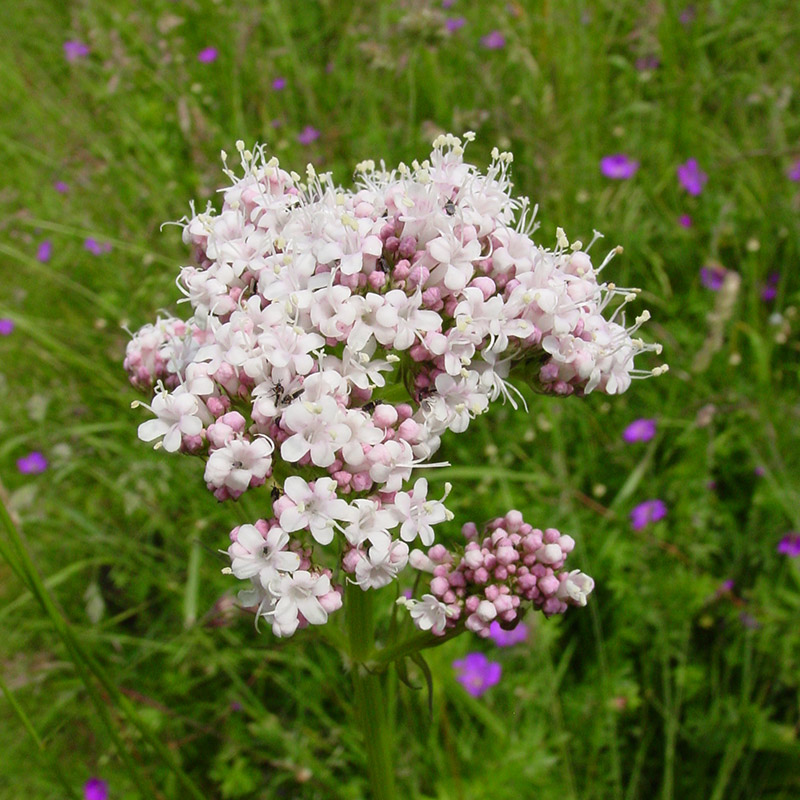Botanical name
Valeriana officinalis L.
Family
Caprifoliaceae
Common name
Common valerian, All-heal, Cat`s valerian, Capon’s tail, Phu
Information about the plant
Valerian is native to Europe and the temperate zones of Asia, grows preferably in moist and shady places. It is a diverse aggregate species, often characterized by the suffix ‘s.l.’ (sensu lato = in the broader sense) added after the Latin plant name (Valeriana officinalis s.l.). The genus name Valeriana is probably derived from the Latin ‘valere’ (= to be healthy) because of the medical properties of the plant. The species epithet officinalis suggests that it is an old medicinal plant because the ‘officina’ is the pharmacy salesroom and ’officinalis’ means ‘commonly used in the pharmacy’.
Valerian is perennial, growing 50 to 100 cm tall. It blossoms from July to September with numerous small, light pink to white flowers arranged in umbels. Both basal and stem leaves are pinnate.
Medicinally used parts of plants (herbal drug)
The underground parts of the plant are used, consisting of short, cylindrical rhizomes and the thin roots attached to them in clusters (valerian root – Valerianae radix). During drying, the typical odor of the drug is formed, caused by the release of isovaleric acid. The essential oil, obtained by distilling the valerian root (valerian oil – Valerianae aetheroleum), is also medicinally used.
The commercially available drug comes from wild collections and crops in Holland, Belgium and Eastern Europe; valerian is also grown in Germany (Thuringia).
Constituents of the herbal drug
Valerian root has a very heterogeneous spectrum of constituents: essential oils, sesquiterpenic acids, iridoids (valepotriates and their degradation products), lignans, caffeic acid derivates, and alkaloids.
In finished medicinal products, the critical valepotriates are present in very low concentrations.
Quality of the drug
The quality of the following drugs or drug preparations is specified in the European Pharmacopoeia (Ph. Eur.):
- Valerian root (Valerianae radix)
- Valerian tincture (Valerianae tinctura)
- Valerian dry extract prepared with hydroalcoholic mixtures (Valerianae extractum hydroalcoholicum siccum)
- Valerian dry extract prepared with water (Valerianae extractum aquosum siccum)
Medical applications
Recognised medical use
The HMPC has accepted valerian root in form of dry extracts (DER 3-7.4:1, extraction solvent: ethanol 40-70%) as “medically recognized” (“well-established use”) for the treatment of mild nervous tension and sleep disorders. It also has accepted as “medically recognized” (“well-established use”) two combinations of valerian root and hop strobile in the form of dry extracts for the relief of sleep disorders; see also “Traditional Use”
ESCOP: relief of temporary mild nervous tension and/or difficulty in falling asleep.
Commission E: restlessness, nervousness, including difficulty in falling asleep.
Traditional use
Valerian root cut drug, other dry extracts, fluid extracts, valerian tincture, pressed juice from fresh valerian root and the essential valerian oil, as well as several preparations of a combination of valerian root and hop, have been classified by the HMPC as a traditional herbal medicinal product (§ 39a AMG). Based on many years of experience, valerian root and hop preparations/valerian root preparations, as well as valerian oil, can be used to treat mild stress-related symptoms and as a sleep aid (see also “Medical application”).
Herbal drug preparations in finished dosage forms
- Cut valerian root for tea preparation and baths, often used in combination with other drugs with a calming effect
- Powdered drugs in tablets and coated tablets (dragées)
- Tincture in drops
- Fluid extract in dops and juices
- Dry extracts in tablets, dragées and soluble instant teas
- Valerian essential oil in bath additives
- Pressed juice from fresh valerian root
Dosage
Finished dosage form: see patient information leaflet
Tea infusion (calming tea): drink 1 to 2 cups of valerian root tea daily in case of difficulty in falling asleep ½ hour before bedtime. Valerian root can be well combined with other sedative drugs (e.g., passionflower herb, hops, lemon balm). An improvement in sleep occurs after 5 to 14 days.
For an evening full bath, approx. 100g of cut valerian root is used; bath time is 15 to 20 min; for a full bath with valerian oil, 300 to 400 mg of valerian oil (approx. 10 drops) are sufficient.
Preparation of a tea
Pour 150 mL of hot water over 2 to 3 g of chopped valerian root and leave covered. Strain after 10 to 15 minutes.
Notes
Because valerian root may impair responsiveness, it is prudent not to drive a car for up to 2 hours after taking a medication containing valerian root.
There are no safety studies on the use of valerian root during pregnancy and lactation; use in children under 12 years of age is not recommended due to lack of data.
Side effects
Mild gastrointestinal complaints.
Interactions
None known
References
Herbal drug monographs
HMPC (2016, 2020), ESCOP (2009), WHO vol. 1
Further literature
Commentary on the European Pharmacopoeia (Valerian root, Nr. 0543; Valerian tincture, Nr. 1899; Valerian dry extract prepared with water, Nr. 2400; Valerian dry extract prepared with hydroalcoholic mixtures, Nr. 1898)



